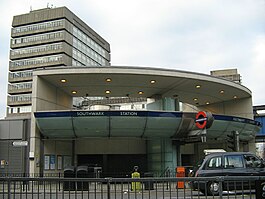Southwark tube station
| Southwark |
|
|---|---|

Entrance on The Cut
|
|
|
Location of Southwark in Central London
|
|
| Location | Bankside |
| Local authority | London Borough of Southwark |
| Managed by | London Underground |
| Number of platforms | 2 |
| Accessible | Yes |
| Fare zone | 1 |
| OSI |
Waterloo East Blackfriars at Bankside entrance |
| London Underground annual entry and exit | |
| 2012 |
|
| 2013 |
|
| 2014 |
|
| 2015 |
|
| Railway companies | |
| Original company | London Regional Transport |
| Key dates | |
| 20 November 1999 | Opened |
| Other information | |
| Lists of stations | |
| WGS84 | 51°30′11″N 0°06′18″W / 51.503°N 0.105°WCoordinates: 51°30′11″N 0°06′18″W / 51.503°N 0.105°W |
|
|
|
Southwark is a London Underground station in the London Borough of Southwark at the corner of Blackfriars Road and The Cut. It is between Waterloo and London Bridge stations on the Jubilee line, and is in Travelcard Zone 1. It was opened on 20 November 1999 as part of the Jubilee Line Extension. The station is somewhat west of historic Southwark, which is served by Borough tube station and London Bridge station. Its entrance is across the street from the disused Blackfriars Road railway station.
The original plan for the Extension did not include a station between those at Waterloo and London Bridge; Southwark station was added after lobbying by the local council, it is in fact sited right next to the borough's boundary with Lambeth at Joane Street. Although it is close to Waterloo, not near the Bankside attractions it was intended to serve, and its only National Rail interchange is to London Waterloo East main line station; the passenger usage matches those of other minor central stations. It does however get over twice the traffic of nearby Borough station, and around three times that of Lambeth North.
Southwark station was designed by Sir Richard MacCormac of MJP Architects. It is on a cramped site, with its platforms underneath the Victorian main line viaduct between Waterloo East and London Bridge stations. The site presented significant technical and architectural difficulties which were resolved by constructing two concourses at different levels.
...
Wikipedia

